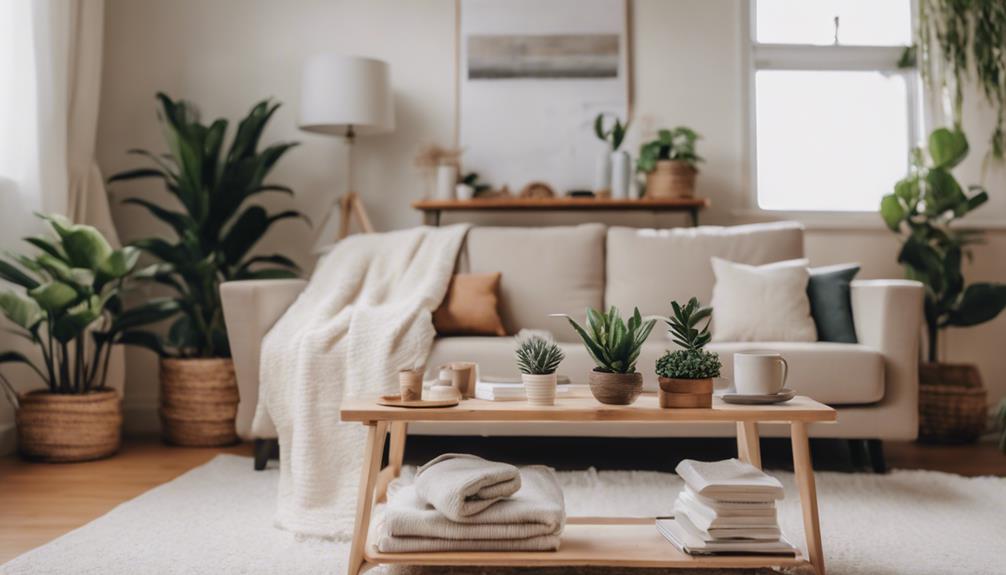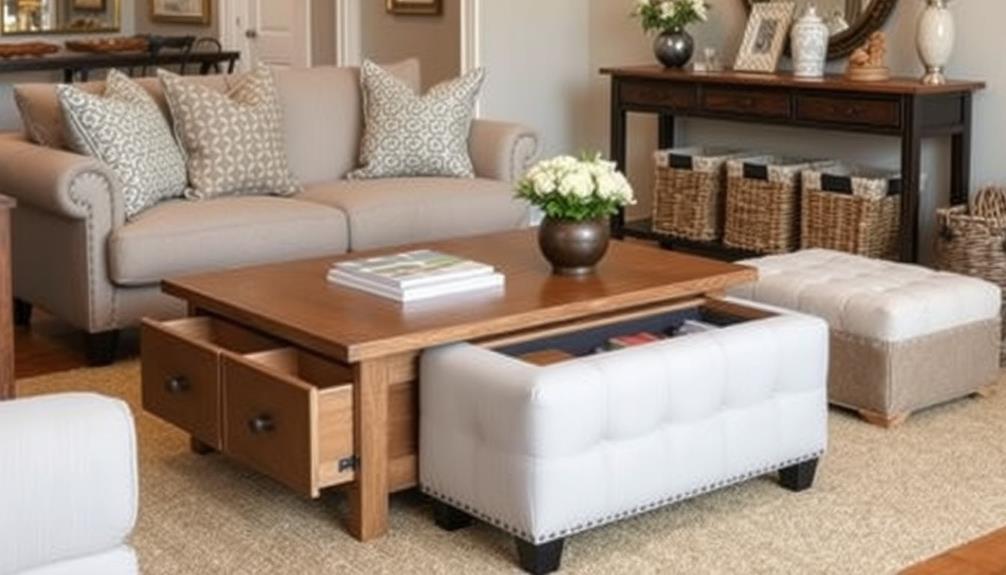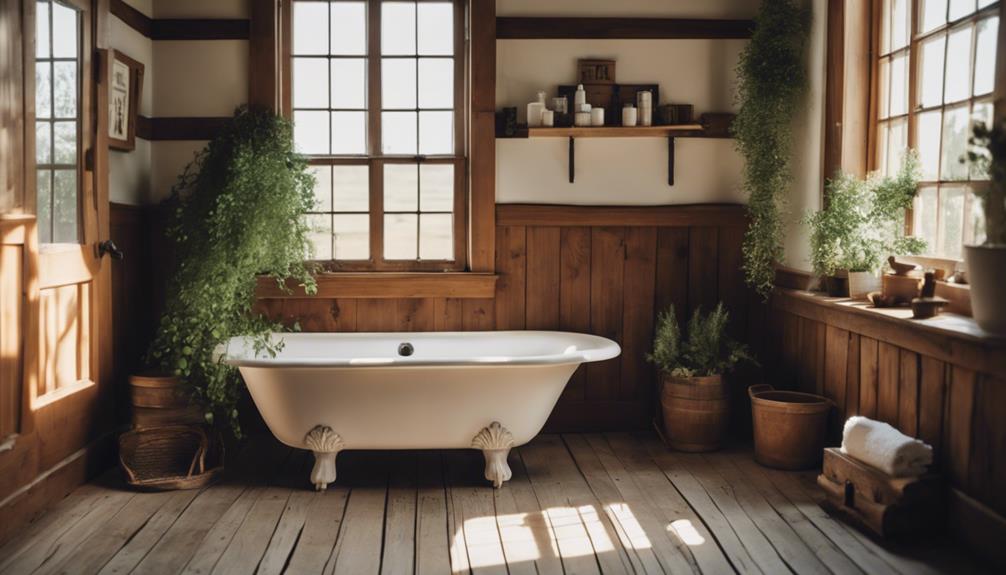A modern farmhouse living room blends contemporary style with rustic charm, creating a cozy and welcoming space. To achieve this look, start with a neutral color palette of whites, grays, and earthy tones for a warm ambiance. Incorporate natural materials like reclaimed wood and metal for added texture. Opt for comfortable furnishings, such as slipcovered sofas and oversized chairs, to promote relaxation and social gatherings. Illuminate the room with statement fixtures and ample natural light from large windows. Add vintage accents to give your decor character. For more tips on achieving the perfect modern farmhouse aesthetic, there is plenty more to discover!
Key Takeaways
- Embrace a neutral color palette with whites, grays, and earthy tones to create a warm, inviting atmosphere in your living room.
- Incorporate natural materials like reclaimed wood and metal to enhance the rustic charm and add texture to the space.
- Choose cozy furnishings such as slipcovered sofas and oversized chairs to promote comfort and encourage social interaction.
- Utilize open layouts to enhance flow between spaces, making your living room a hub for family gatherings and relaxation.
Overview of Modern Farmhouse Style
Modern farmhouse style effortlessly combines rustic charm with contemporary design, creating cozy and inviting spaces that feel both warm and practical.
When you step into modern farmhouse interiors, you'll notice a perfect blend of vintage and modern elements that make the space feel unique. Natural materials like wood and stone play an essential role, adding texture and warmth while reinforcing that rustic aesthetic.
The color palette typically leans towards neutral tones, allowing the beauty of the materials to shine through. Open floor plans are a hallmark of this style, promoting an inviting atmosphere where family and friends can gather comfortably.
Large windows flood the space with natural light, enhancing the overall warmth and inviting you to relax. You'll often find a mix of antique furniture and contemporary decor, creating a personalized environment that feels lived-in yet stylish.
Cozy textiles like linens and jute enhance comfort, making the space feel approachable and homey. Decorative accents, from statement lighting to greenery, complete the look, ensuring your modern farmhouse living room remains both functional and aesthetically pleasing.
Essential Design Elements
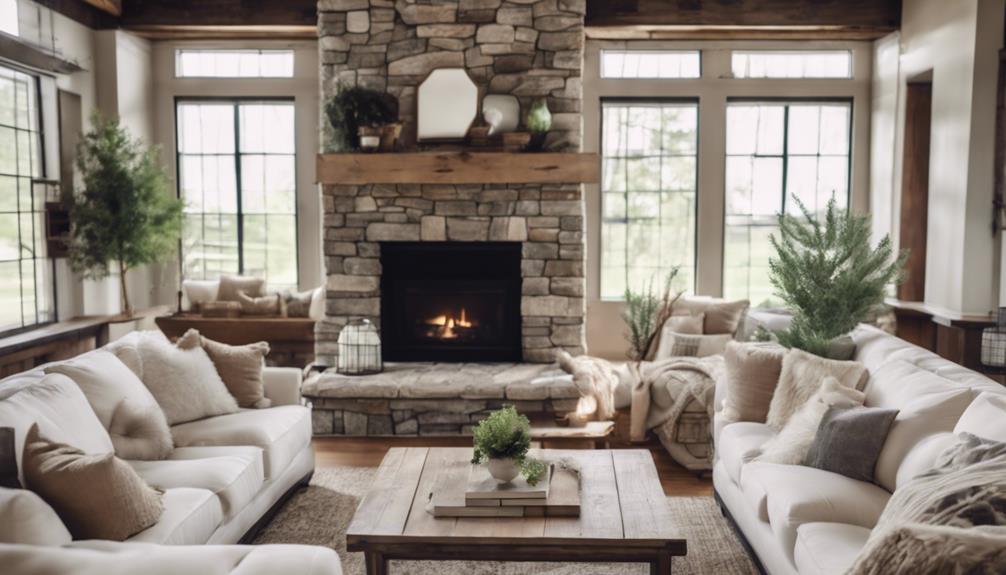
Incorporating key design elements is essential for creating a modern farmhouse living room that feels both inviting and stylish.
Start with a neutral color palette, including whites, grays, and earthy tones, to establish a warm atmosphere. Natural materials like reclaimed wood, stone, and metal add rustic charm while enhancing the contemporary aesthetic.
Cozy furnishings are a must; opt for slipcovered sofas and oversized armchairs that promote comfort and are easy to maintain. These pieces help create a relaxed vibe, perfect for unwinding after a long day.
Don't forget to include vintage accents, such as antique coffee tables or rustic decor items, which provide character and authenticity, beautifully blending with modern design elements.
Open floor plans are another vital aspect of your interior design. They enhance the flow between the living room and adjacent spaces, encouraging social interaction and making the area feel more spacious.
Choosing the Right Furniture

Selecting the right furniture is essential for achieving a cozy and stylish modern farmhouse living room.
Start with a sofa featuring a slipcover in a neutral tone; it's easy to maintain and enhances the inviting aesthetic of modern farmhouse design. Pair it with a reclaimed wood coffee table that serves as a stunning focal point, adding rustic charm and a touch of sustainability to your decor.
Accent chairs are important too. Look for those with modern lines and textures to create a contrast that maintains comfort while adhering to the overall theme.
When it comes to the dining area, select a farmhouse-style dining table that promotes togetherness and family gatherings, seamlessly fitting into your design vision.
Don't forget about decorative shelving. This furniture piece not only displays curated items but also combines functionality with style, keeping your space organized and inviting.
Color Schemes and Textures
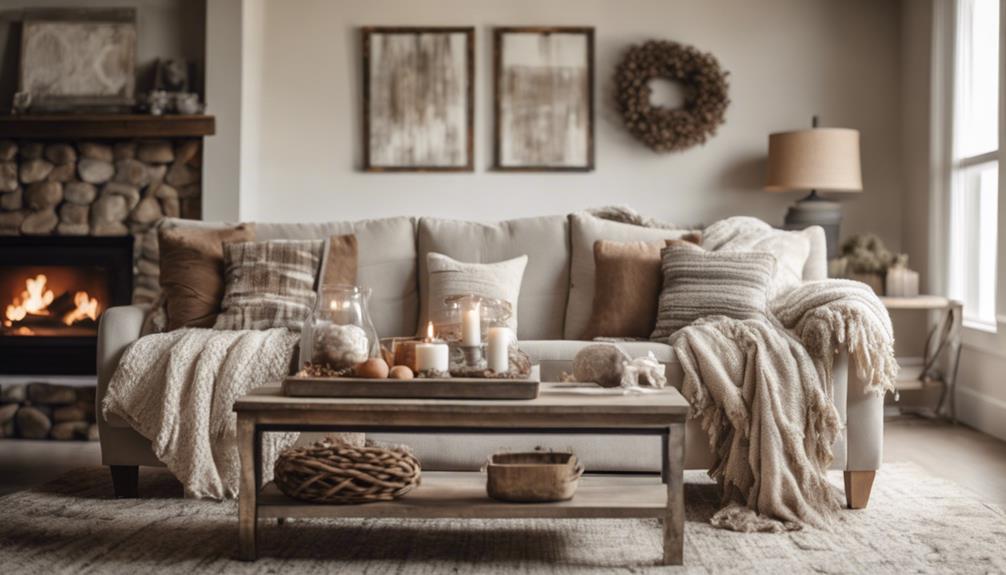
To create a welcoming atmosphere in your modern farmhouse living room, focus on a neutral color palette that features soft whites, grays, and beiges. These colors not only brighten your space but also provide a versatile backdrop for your decor. Incorporating earthy tones like taupe and sage green can add warmth and complement the natural materials, such as wood and stone, often found in farmhouse designs.
Textures play a vital role in achieving the farmhouse aesthetic. You can enhance the cozy feel of your living room by using textured fabrics like linen, jute, and cotton for your throw pillows, rugs, and curtains. These materials invite comfort and create a layered look that's visually appealing.
Don't shy away from mixing sleek, modern surfaces with rustic finishes, like reclaimed wood or distressed furniture. This contrast adds depth and visual interest to your decor.
Additionally, consider seasonal changes to your color schemes; introducing patterned textiles or colorful accents can refresh your living room while maintaining its overall charm. By thoughtfully selecting colors and textures, you'll create a space that feels both contemporary and inviting.
Decorative Accents for Character
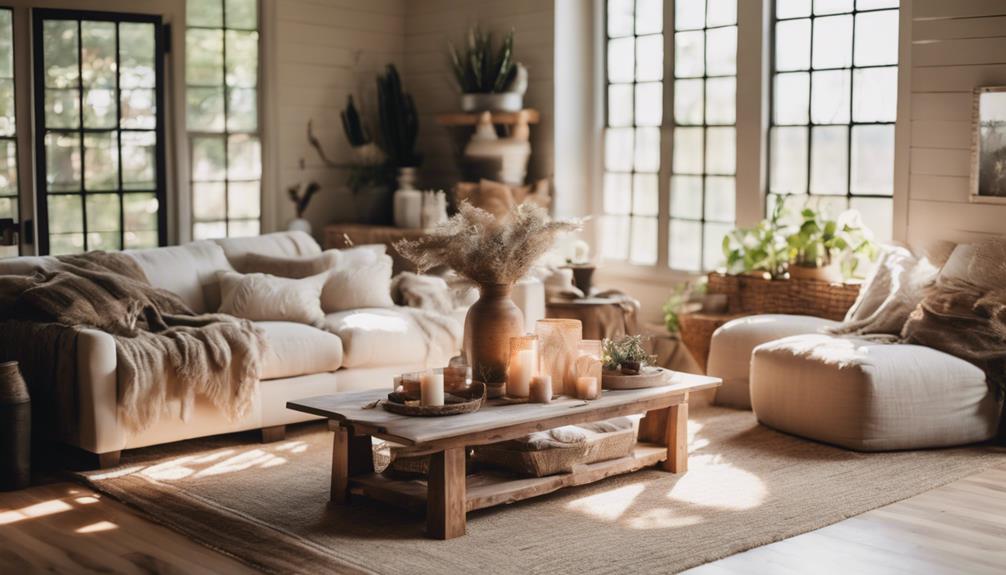
To give your modern farmhouse living room real character, consider incorporating vintage decor elements, like antique picture frames or handmade textiles.
Don't overlook the impact of statement lighting fixtures, which can serve as both functional and eye-catching features.
Vintage Decor Elements
Incorporating vintage decor elements like antique furniture and reclaimed wood accents instantly adds character and warmth to your modern farmhouse living room. These unique pieces serve as conversation starters, drawing attention with their rich history and craftsmanship. Consider mixing rustic accents, such as a weathered coffee table or a vintage rocking chair, to create a cozy and inviting atmosphere.
Don't underestimate the power of vintage accessories either. Old books, rustic clocks, and classic signage can enhance the authenticity of your space, infusing it with nostalgia. By combining these vintage decor elements with contemporary pieces, you create visual interest and depth, making your living room feel truly personalized.
Handcrafted items, like quilts or pottery, can also emphasize your connection to history and craftsmanship. They add an artisanal touch, enriching your overall aesthetic.
Natural Textiles Usage
Vintage decor elements set the stage for showcasing natural textiles, which play an essential role in enhancing the warmth and comfort of your modern farmhouse living room. Incorporating materials like linen, cotton, and jute creates a cozy atmosphere that invites relaxation. These fabrics provide a tactile contrast to the harder surfaces of wood and metal, making your space feel both inviting and stylish.
You can easily layer different textiles, such as chunky knit throws and soft cotton pillows, to create visual interest and depth. This layering not only adds character but also enhances the welcoming feel of your living area. Opting for natural fibers aligns with eco-friendly principles, promoting sustainability while maintaining the rustic charm of your home.
Using neutral tones in your natural textiles allows for a seamless integration with the overall color palette of your farmhouse, ensuring a cohesive look. Feel free to introduce occasional patterned fabrics for a pop of personality without overwhelming the design. By thoughtfully incorporating natural textiles, you'll achieve a balanced and inviting space that truly embodies modern farmhouse living.
Statement Lighting Fixtures
Statement lighting fixtures can transform your modern farmhouse living room by serving as striking focal points that blend rustic elegance with contemporary style. Oversized pendant lights or wrought iron chandeliers not only illuminate your space but also add character, making them essential in achieving that warm, inviting atmosphere.
Incorporating vintage-inspired designs, like Edison bulb fixtures, enhances the rustic charm while providing a cozy glow. The use of mixed materials, such as wood and metal, complements the natural elements throughout your modern farmhouse, creating a harmonious balance.
Layered lighting is key; combine ambient, task, and accent fixtures to craft a welcoming environment. This not only highlights decorative accents but also allows you to tailor the lighting to different activities.
Choosing fixtures with unique designs or distressed finishes infuses personality into your room, reinforcing the blend of contemporary style and rustic charm that defines modern farmhouse decor.
Whether you opt for a striking chandelier or a simple pendant, these statement lighting fixtures will elevate your living room, making it both functional and visually appealing. Embrace the charm they bring to create a truly enchanting space.
Creating Functional Layouts
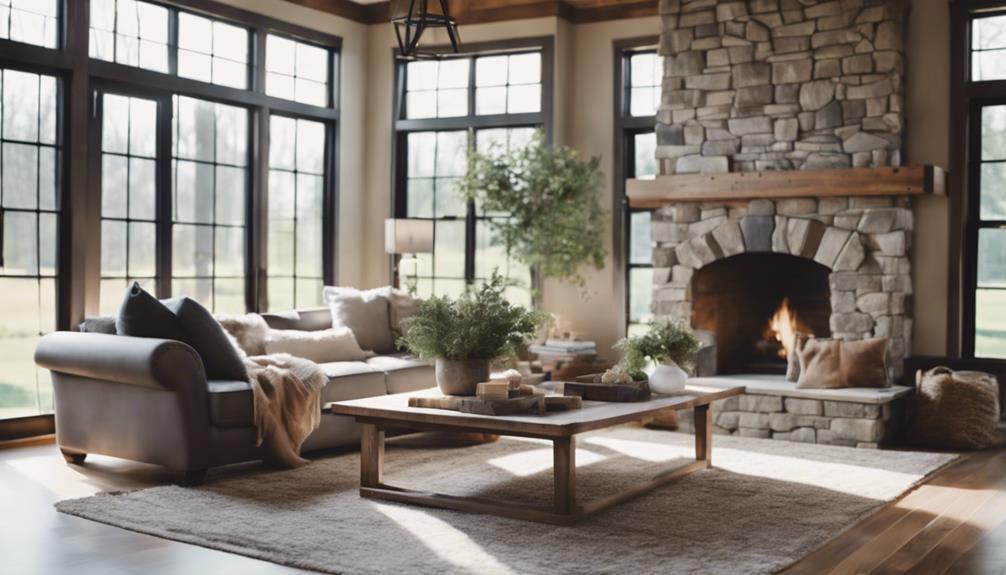
Creating a functional layout in your modern farmhouse living room involves thoughtfully arranging furniture to enhance flow and foster social interactions. Embrace open floor plans that allow seamless shifts between spaces, making your home feel more inviting.
You'll want to define functional zones while guaranteeing pathways remain clear. Here are some tips to take into account:
- Position sofas and chairs to create cozy conversation areas.
- Incorporate multifunctional furniture, like ottomans with storage or expandable coffee tables.
- Use layering rugs to add depth and comfort while delineating different areas.
- Strategically place large windows to invite natural light and connect indoor and outdoor spaces.
Tips for Personalization
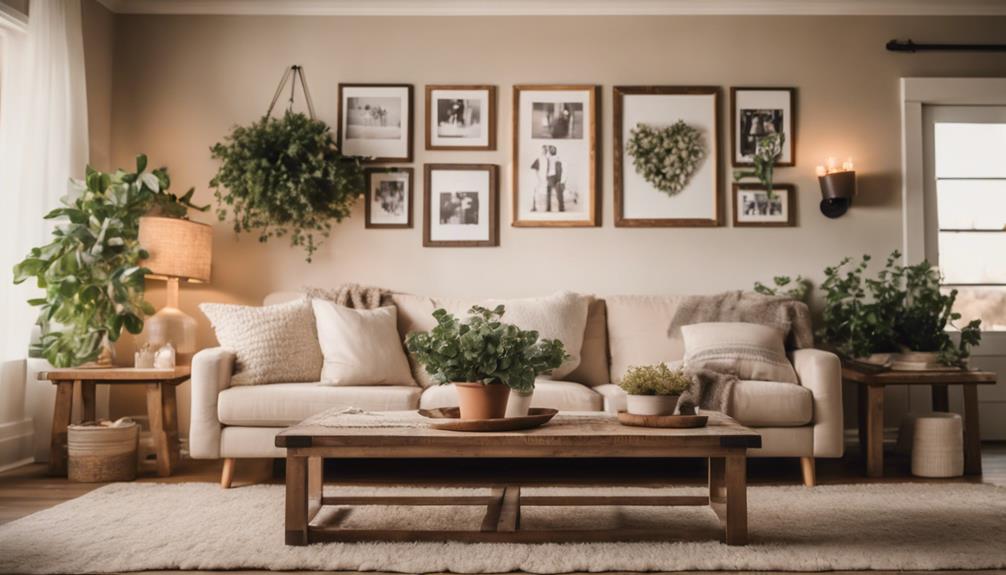
To truly make your modern farmhouse living room feel like home, regularly incorporate personal touches that reflect your unique style and memories. Start by displaying personal memorabilia, like family photos in vintage frames or cherished heirloom pieces. This adds a unique touch and evokes sentimental value.
Mixing textures is another great way to enhance the cozy, rustic feel. Combine soft linens with rugged burlap or reclaimed wood to create visual interest. Don't forget about your color palette—select hues that resonate with you. Add vibrant throw pillows or artwork while maintaining a neutral base characteristic of modern farmhouse design.
Consider creating a gallery wall using a curated collection of art, mirrors, and personal mementos to showcase your individuality. DIY elements, such as hand-painted furniture or homemade decor, can also express your creativity while staying true to the farmhouse aesthetic.
Here's a quick reference table to inspire your personalization journey:
| Element | Ideas | Benefits |
|---|---|---|
| Personal Memorabilia | Family photos, heirlooms | Evokes sentiment and warmth |
| Textures | Soft linens, burlap, wood | Adds visual interest |
| Color Palette | Vibrant pillows, artwork | Reflects personality |
Incorporating Natural Light

To create a bright and inviting modern farmhouse living room, you'll want to focus on maximizing window placement and using light-colored fabrics.
Reflective surfaces can also play a key role in bouncing light around the space.
Maximizing Window Placement
Strategically placing large windows in your modern farmhouse living room invites an abundance of natural light, instantly brightening the space and enhancing its cozy appeal. By maximizing window placement, you create an inviting atmosphere that harmonizes contemporary rustic charm with modern amenities.
Consider these tips for effective window placement:
- Install floor-to-ceiling windows to blur the lines between indoor and outdoor spaces, allowing for breathtaking views.
- Utilize transom windows above doors or standard windows to increase light flow while maintaining privacy.
- Orient windows to face south for ideal sunlight exposure, reducing your reliance on artificial lighting.
- Incorporate window treatments like sheer curtains or blinds to control light levels without sacrificing the aesthetic benefits of natural illumination.
Using Light-Colored Fabrics
Maximizing natural light through thoughtful window placement sets the stage for using light-colored fabrics that enhance the airy feel of your modern farmhouse living room.
Light-colored fabrics, like whites, creams, and soft pastels, reflect sunlight beautifully, creating an airy and open atmosphere. When you choose upholstery in these shades for your sofas and chairs, you'll notice how they visually expand the space, making it feel larger and more welcoming.
Incorporating natural materials like linen and cotton in light shades not only promotes a cozy and inviting vibe but also maintains a fresh aesthetic. Layering these light fabrics with textured throws and cushions adds depth to your design, achieving a balance between comfort and style without overwhelming the room.
Strategically placing these light-colored fabrics near windows allows for the maximum reflection of natural light, enhancing the overall brightness of your living area.
Reflective Surfaces for Brightness
Incorporating reflective surfaces like mirrors and glossy finishes regularly brightens your modern farmhouse living room, enhancing the sense of space and warmth. By strategically placing these elements, you can amplify natural light, making your space feel airy and inviting.
Consider these tips to effectively use reflective surfaces in your living room:
- Position mirrors across from windows to bounce light throughout the room.
- Choose light-colored, reflective furniture, such as glass-topped coffee tables, to enhance luminosity.
- Opt for metallic accents that catch the light and add a touch of elegance.
- Incorporate decor elements like framed artwork with glass fronts to add depth.
These strategies not only highlight the beauty of rustic materials but also guarantee that your living area feels spacious and bright.
Embrace the charm of reflective surfaces to transform your living room into a warm and inviting retreat.
Emphasizing Comfort and Warmth
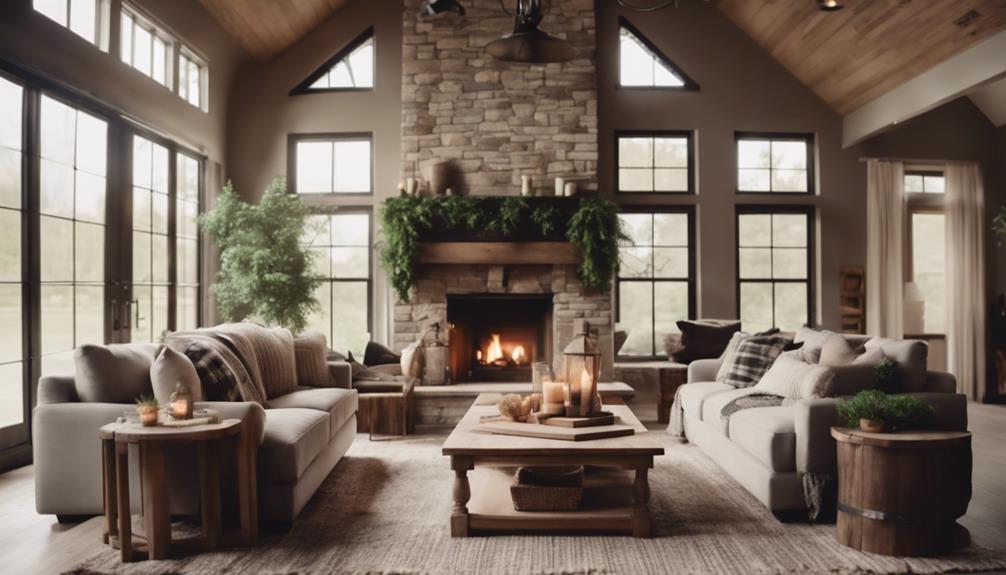
A modern farmhouse living room embraces comfort and warmth through plush seating options and natural materials that invite you to relax and unwind. You'll find oversized sofas and cozy armchairs draped in soft fabrics like linen or cotton, creating an inviting atmosphere that encourages you to sink in. The use of reclaimed wood for furniture and decor not only adds rustic charm but also enhances the room's overall warmth.
Layering textiles, such as throw blankets and decorative pillows in earthy tones, invites you to snuggle up and enjoy the cozy ambiance. These elements contribute to a sense of comfort, making the space feel like a true retreat. The open-concept layout further amplifies this warmth, facilitating social interaction and creating a welcoming environment for family gatherings or entertaining friends.
Don't overlook the statement lighting fixtures, like wrought iron chandeliers or rustic pendant lights. They not only illuminate the space but also serve as beautiful focal points that enhance the room's charm. By combining these elements, your modern farmhouse living room becomes a perfect blend of comfort and warmth, inviting you to enjoy every moment spent there.
Trends in Modern Farmhouse Design
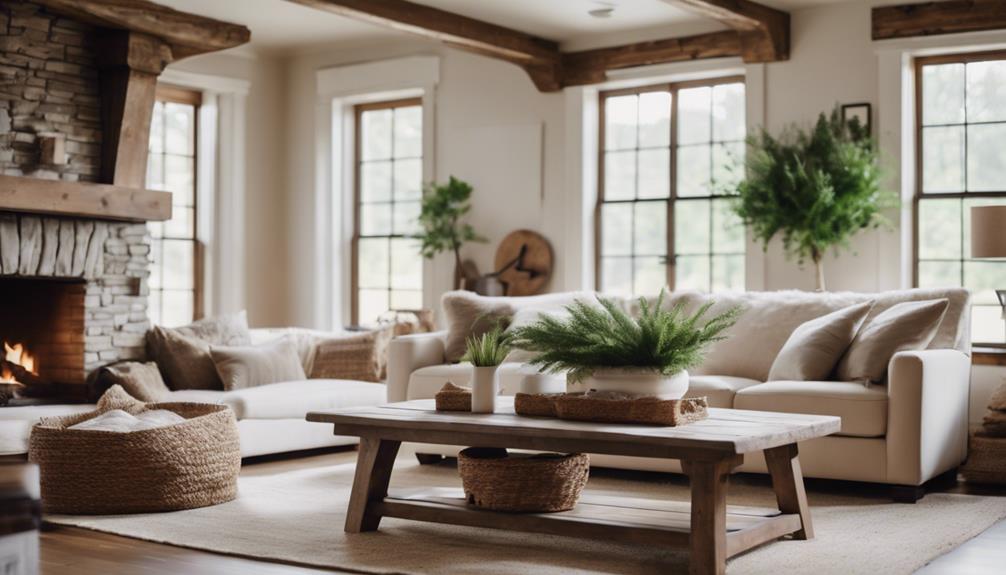
When you think about modern farmhouse design, open concept layouts, textured fabrics, and vintage-modern furniture blends come to mind.
These trends not only enhance the functionality of your living space but also create a warm and inviting atmosphere.
Let's explore how each of these elements can transform your farmhouse living room.
Open Concept Layouts
Open concept layouts in modern farmhouse design create a harmonious flow between living, dining, and kitchen areas, making it easier for families to connect and socialize. These layouts enhance the overall experience of gatherings, allowing hosts to engage with guests without feeling isolated.
Key features of open concept layouts include:
- Large, unobstructed spaces that invite natural light, creating a bright and welcoming atmosphere.
- Multifunctional furniture, like storage ottomans and expandable dining tables, that maximizes usability while maintaining coziness.
- Architectural elements such as exposed beams and shiplap walls that provide rustic charm and delineate spaces without sacrificing modern aesthetics.
- Seamless shifts between areas, encouraging effortless movement and interaction among family members and guests.
Textured Fabrics and Materials
Textured fabrics and materials play an essential role in modern farmhouse living rooms, adding warmth and character to the space. You can create a cozy atmosphere by incorporating fabrics like linen, jute, and cotton. Layering different textures, such as chunky knit throws paired with smooth leather couches, enhances visual interest and depth in your decor.
Using natural materials like wool and canvas for cushions and rugs enhances the rustic charm while providing comfort and durability. Reclaimed wood and vintage textiles contribute to an authentic farmhouse aesthetic, harmonizing beautifully with contemporary design features. Soft, muted tones in fabric choices complement the neutral color palettes typical of modern farmhouse style, promoting a serene and inviting atmosphere.
Here's a little table to inspire you:
| Fabric Type | Texture Level | Feelings Evoked |
|---|---|---|
| Linen | Soft | Calm and Relaxed |
| Jute | Rough | Earthy and Grounded |
| Chunky Knit | Cozy | Warm and Inviting |
Vintage-Modern Furniture Blends
Blending vintage and modern furniture in your living room can create a unique aesthetic that perfectly balances rustic charm with contemporary sophistication. This approach is essential in modern farmhouse design, where the combination of old and new not only enhances the space but also reflects your personal style.
Consider these key elements for achieving the perfect vintage-modern furniture blend:
- Reclaimed wood coffee tables paired with minimalist sofas for a stylish focal point.
- Accent chairs that feature modern lines and textures, contrasting beautifully with vintage pieces.
- Antique side tables or retro light fixtures that add character and a sense of history.
- Sleek shelving units to display cherished vintage accessories while maintaining a contemporary feel.
Mixing vintage-modern furniture in your modern farmhouse living room enriches the decor, creating depth and warmth. This fusion not only showcases your history and taste but also invites a cozy atmosphere where you can truly feel at home.
Embrace this trend to achieve a sophisticated yet inviting living space.
Frequently Asked Questions
What Trend Is Replacing Modern Farmhouses?
You'll notice that modern minimalism is replacing modern farmhouse trends. It emphasizes simplicity and clean lines, while Scandinavian design, industrial chic, and bohemian styles also gain traction, offering fresh alternatives to traditional rustic aesthetics.
Does Contemporary Go With Farmhouse?
Imagine a sleek metal coffee table paired with a rustic reclaimed wood sofa. Yes, contemporary really does go with farmhouse! You just need to blend textures and colors to create a harmonious, inviting space.
What Is the Difference Between Modern Farmhouse and Rustic Farmhouse?
The difference between modern farmhouse and rustic farmhouse lies in style. You'll find modern farmhouse features sleek lines and neutrals, while rustic farmhouse embraces rugged, traditional aesthetics with earthy tones and vintage materials for a cozy feel.
What Is Rustic Farmhouse Decor?
Did you know 70% of people prefer cozy, rustic decor? Rustic farmhouse decor blends natural materials, neutral colors, and vintage accents, creating a warm atmosphere. You'll love how textures and greenery enhance its inviting charm.
Can the Organic and Natural Aesthetic of Farmhouse Skincare be Incorporated into a Modern Farmhouse Living Room?
The organic natural skincare aesthetic of farmhouse skincare can definitely be incorporated into a modern farmhouse living room. By using raw wood accents, earthy color palettes, and natural textiles, you can bring the same cozy, rustic vibe from your skincare routine into your home decor.
Conclusion
To sum up, embracing modern farmhouse living means you can finally justify having that vintage tractor in your living room—after all, it's “rustic charm,” right?
By blending cozy furnishings, warm colors, and natural light, you'll create a space that feels both stylish and lived-in.
So go ahead, mix that old barn wood with sleek modern accents. Who knew you could turn your home into a Pinterest board while keeping your inner farmer happy?
Welcome to the new chic!

